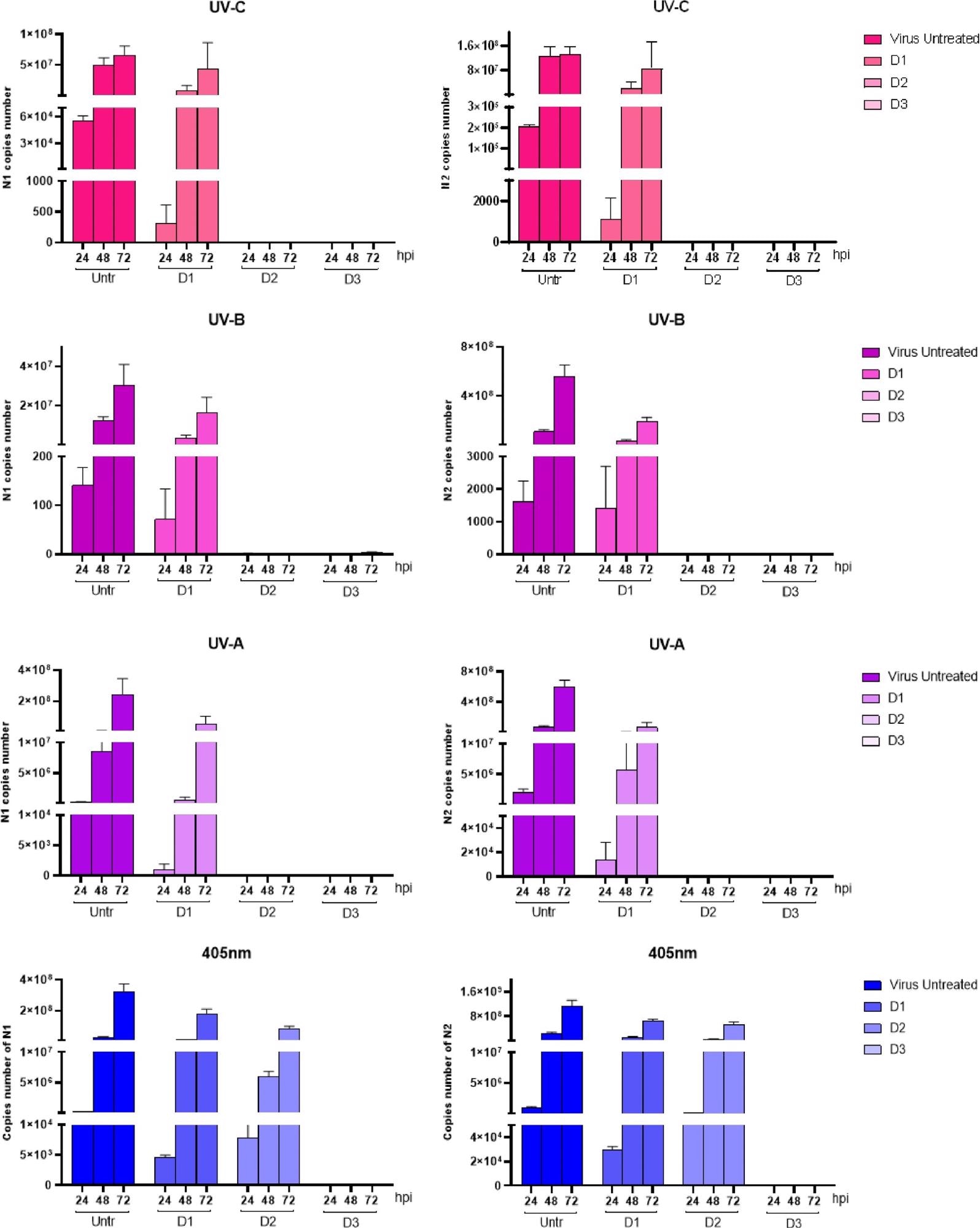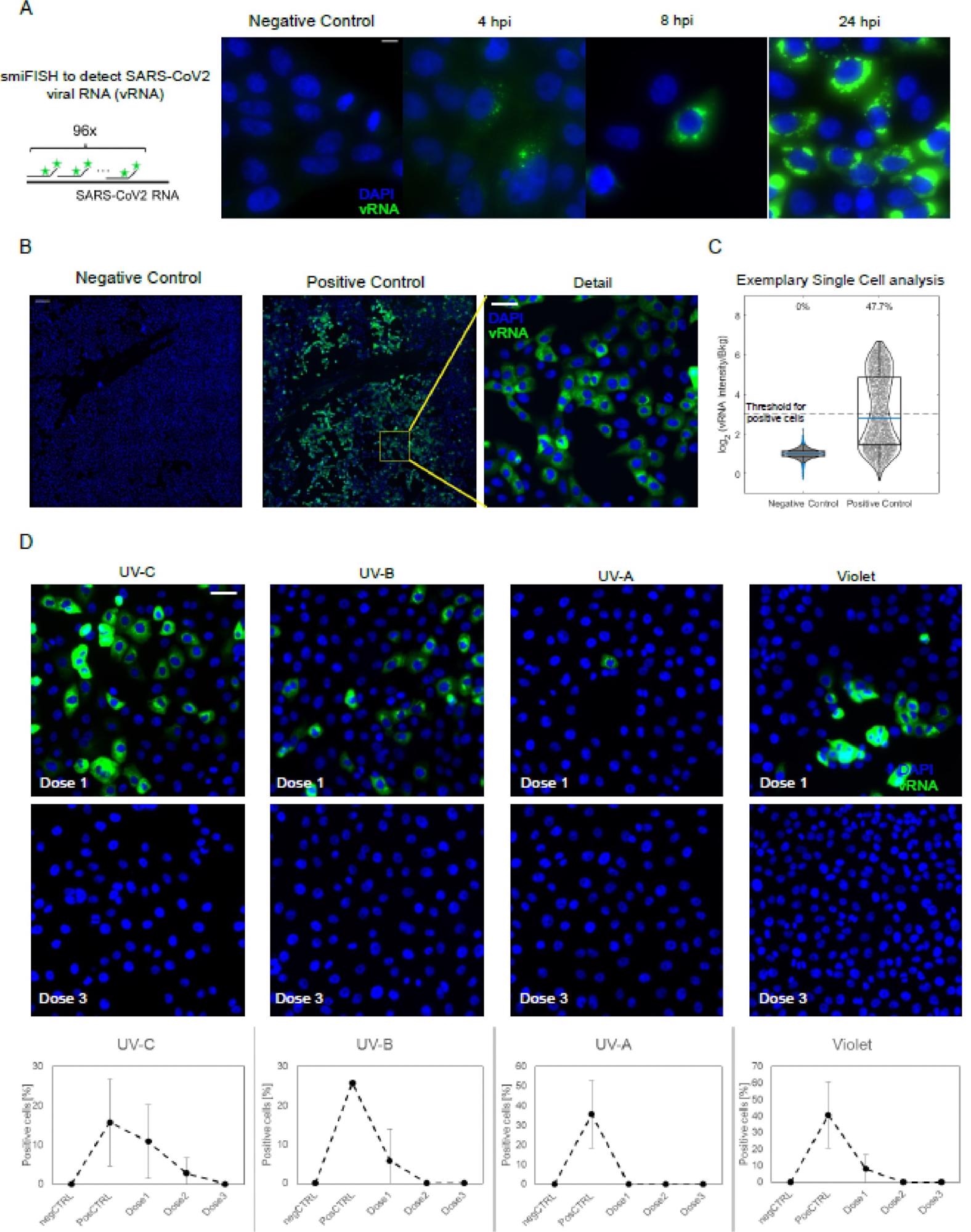Amid the unprecedented public health crisis caused by the coronavirus disease 2019 (COVID-19, strategies for disinfection and prevention are of prime importance. The germicidal effect of UV light has been widely applied to the disinfection of drinking water, wastewaters, closed spaces, and blood products. However, SARS-CoV-2 exhibits high sensitivity towards UV-C light in particular, and comprehensive studies are needed to ascertain the light’s virucidal effect on the virus.
About the study
The present study analyzed the virucidal effect of distinct wavelengths of UV and violet lights on SARS-CoV-2 samples. The researchers also investigated the inactivation of SARS-CoV-2 on exposure to long UV-wavelengths using the quantitative polymerase chain reaction (qPCR) and fluorescence in situ hybridization (FISH) approach.
An initial median tissue culture infectious dose (TCID50) of 6 x 106 TCID50/mL was used to investigate the inhibition of SARS-CoV-2 on irradiation with wavelengths ranging from UV-C to violet light. A SARS-CoV-2 viral stock of concentration 1.5 x 103 TCID50/mL was also used to study the effect of the same wavelength on a different viral concentration. The qPCR and FISH techniques were then used to quantify the UV-A and UV-B doses required to inactivate SARS-CoV-2 present in concentrations equivalent to one in the sputum of a SARS-CoV-2-infected patient.
The researchers also compared the UV action spectrum for SARS-CoV-2 to that of other viruses, including influenza virus H1N1 bacteriophages like MS2, T1, and T4 and bacteria including Escherichia Coli alone or combined with Salmonella. In particular, qPCR enabled the study of the capability of the irradiated virus to replicate over time.
The sensitivity of SARS-CoV-2 to irradiation was assessed using a SARS-CoV-2 stock solution at a concentration of 6 x 106 TCID50/mL. This solution was then subjected to three different doses of each UV wavelength. The SARS-CoV-2 stock solution that was not exposed to any UV light was considered as a control.
Results
A dose-response relationship was observed between the UV dose and the viral titer, demonstrating different extents of sensitivity of SARS-CoV-2 towards different UV wavelengths. Also, while a small UV-C dose could cause a significant reduction in effective viral concentration, a 100-1000x higher dose of UV-B and UV-A irradiation was needed to inactivate the virus.
 Viral replication of UV-irradiated SARS-CoV-2 (1,5 × 106 TCID50) in the supernatant of in vitro infected VeroE6 cells. Vero E6 cells were infected with SARS-CoV-2 irradiated with different doses of UV-A (D1 = 2000, D2 = 4000, D3 = 12000 mJ/cm2), -B (D1 = 100, D2 = 200, D3 = 600 mJ/cm2), -C (D1 = 2, D2 = 4, D3 = 12 mJ/cm2) and violet light (D1 = 4000, D2 = 8000, D3 = 24000 mJ/cm2). Culture supernatants were harvested at the indicated times (24, 48 and 72 hpi) and virus titers were measured by absolute copy number quantification (Real-Time PCR). All cell culture conditions were seeded in quadruplicate. Mean values ±SEM are shown.
Viral replication of UV-irradiated SARS-CoV-2 (1,5 × 106 TCID50) in the supernatant of in vitro infected VeroE6 cells. Vero E6 cells were infected with SARS-CoV-2 irradiated with different doses of UV-A (D1 = 2000, D2 = 4000, D3 = 12000 mJ/cm2), -B (D1 = 100, D2 = 200, D3 = 600 mJ/cm2), -C (D1 = 2, D2 = 4, D3 = 12 mJ/cm2) and violet light (D1 = 4000, D2 = 8000, D3 = 24000 mJ/cm2). Culture supernatants were harvested at the indicated times (24, 48 and 72 hpi) and virus titers were measured by absolute copy number quantification (Real-Time PCR). All cell culture conditions were seeded in quadruplicate. Mean values ±SEM are shown.
The study confirmed that UV-C is more effective in causing SARS-CoV-2 inactivation than UV-B and UV-A. Moreover, UV-C was found to be 104 times more effective at generating a virucidal effect on SARS-CoV-2 than violet light. However, it was noted that higher doses of UV-A and violet light could significantly inactivate the virus.
The results indicated that the wavelengths analyzed in this study had a virucidal effect on the SARS-CoV-2 virus, albeit at different concentrations with different efficacies. The virucidal effect was particularly demonstrated at lower viral concentrations 24 hours after a low dose of UV-C irradiation. Notably, the viral concentration did not increase over time, thus indicating complete inhibition of the virus.
The study concluded that a 4 mJ/cm2 UV-C dose, a 100 mJ/cm2 UV-B dose, a 4000 mJ/cm2 UV-A dose, and a 24000 mJ/cm2 violet dose could effectively lower the viral concentration and inactivate SARS-CoV-2.
 Fluorescence In-situ hybridization (FISH) of the SARS-CoV-2 viral RNA (vRNA) in VeroE6 cells. (A) Scheme of the hybridization of the FISH probes (left) and timecourse of SARS-CoV-2 infection at different timepoints post-infection, as collected with an high magnification/Numerical aperture (NA) objective (60 × 1.49NA). Scale bar 10 μm. (B) The bright signal of the smFISH probes at 24hpi allow to use a low NA objective (20x, 0.45 NA) to reliably identify infected cells among thousands of cells, by collecting 6 × 6 mosaics (total field of view approx. 3mm, scale bar in the ‘detail’ image 50 μm).(c) Positive cells are identified as those with a 8-fold higher intensity I than the background n the FISH channel. (D) Exemplary details of 6 × 6 mosaics upon irradiation with different wavelength and doses of UV/Violet light. Quantification is provided as mean +/- standard deviation of the fraction of vRNA positive cells on at least two 6 × 6 mosaics. Scale bar: 10 μm.
Fluorescence In-situ hybridization (FISH) of the SARS-CoV-2 viral RNA (vRNA) in VeroE6 cells. (A) Scheme of the hybridization of the FISH probes (left) and timecourse of SARS-CoV-2 infection at different timepoints post-infection, as collected with an high magnification/Numerical aperture (NA) objective (60 × 1.49NA). Scale bar 10 μm. (B) The bright signal of the smFISH probes at 24hpi allow to use a low NA objective (20x, 0.45 NA) to reliably identify infected cells among thousands of cells, by collecting 6 × 6 mosaics (total field of view approx. 3mm, scale bar in the ‘detail’ image 50 μm).(c) Positive cells are identified as those with a 8-fold higher intensity I than the background n the FISH channel. (D) Exemplary details of 6 × 6 mosaics upon irradiation with different wavelength and doses of UV/Violet light. Quantification is provided as mean +/- standard deviation of the fraction of vRNA positive cells on at least two 6 × 6 mosaics. Scale bar: 10 μm.
Conclusion
The study results show that the viral load of SARS-CoV-2 in the stock was entirely inactivated by UV-C, UV-A and UV-B light, as was observed through the qPCR and FISH techniques. Moreover, the action spectrums of SARS-CoV-2, when compared to other pathogens, establish that RNA viruses are specifically more sensitive to UV-A wavelengths. Since UV-C was more effective at inactivating the virus as compared to UV-A and UV-B, rapid inactivation of the virus can be efficiently undertaken using UV-C irradiation.
The authors believe that the results of this study can be used to formulate predictive models of virus seasonality. The proven ability of UV and violet light in reducing the virulence of SARS-CoV-2 establishes the disinfecting effect of solar radiation on the virus. This research can also play a crucial role in the development of models to study the impact of solar irradiation on the dispersion of viruses in the atmosphere.
Journal reference:
- UV and violet light can Neutralize SARS-CoV-2 Infectivity, Mara Biasin, Sergio Strizzi, Andrea Bianco, Alberto Macchi, Olga Utyro, Giovanni Pareschi, Alessia Loffreda, Adalberto Cavalleri, Manuela Lualdi, Daria Trabattoni, Carlo Tacchetti, Davide Mazza, Mario Clerici. Journal of Photochemistry and Photobiology 2022, 100107, ISSN 2666-4690, DOI: https://doi.org/10.1016/j.jpap.2021.100107, https://www.sciencedirect.com/science/article/pii/S2666469021000920?via%3Dihub